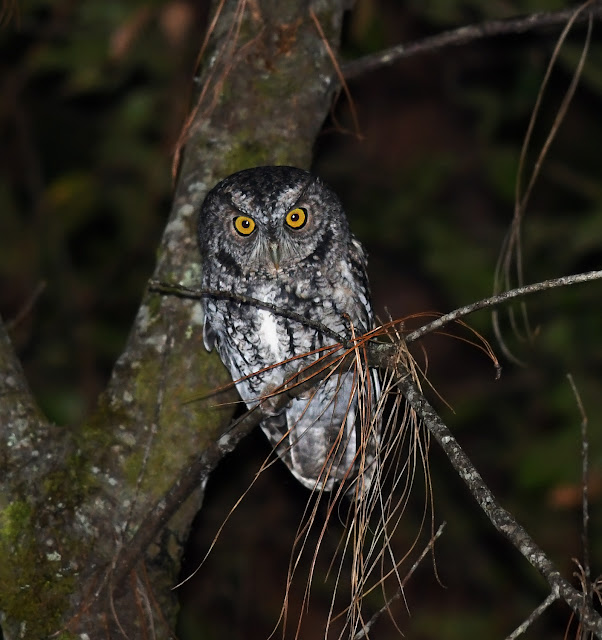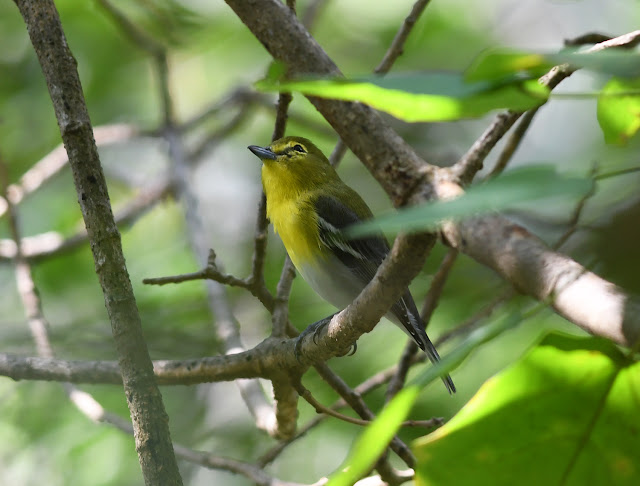Our time in Chiapas was ending, but first, we had a day in the city of San Cristobal de las Casas, widely considered the cultural capital of the state. My target birds were limited since I had explored similar habitats in Guatemala in 2019. Laura and I had had a busy few days and needed some downtime; therefore, we did not see much of the cultural side of the city while our birding was also limited. Instead, we caught up on photo editing, journal writing, laundry, and other necessary chores. Our host’s three dogs required a lot of petting as well!
Birding around San Cristobal de las Casas can be tricky as there are not many places with high quality montane forest and easy access. Several Pronatura reserves on the outskirts of the city including Huitepec and Moxviquil supposedly do not open until 9 AM, while I had also read that the forest quality was poor (lots of second growth). The Dos Lagunas area southeast of San Cristobal de las Casas has a tenuous history with birders. Apparently, some members of the communities here have been known to damage vehicles, harass and extort birders, break into vehicles, and generally give off an unwelcoming and threatening vibe. It seems, in my uninformed opinion, that an entry fee requirement would be a simple solution that would be beneficial to everyone. But I don’t know the nuances of the situation. Alas, Laura and I were not willing to risk a clandestine visit here.
We settled on Parque Ecoturistico Montetik. Located just southeast of San Cristobal de las Casas, a series of trails snake through the pine forest while a gravel road popular with cyclists heads in a straight line for several kilometres. Adjacent to the far side of this park is a restricted access road, owned by several of the indigenous communities, that ascends into much higher quality oak-pine forest.
 |
| San Cristobal de las Casas area, Chiapas, Mexico |
Our arrival time was somewhat delayed due to a Google Maps gaffe that led us through a maze of one-way streets becoming progressively narrower and narrower, and leading to a dead-end that required me to back out for several hundred metres. Fun! Waze had already been fired several times over during the trip, and Google Maps was really testing our patience too. Finally, we found the correct road but it was already 8:30 AM when we arrived. We paid the entrance fee and began searching for birds.
 |
| Parque Ecológico Montetik - San Cristobal de las Casas, Chiapas, Mexico |
We could easily see that the forest here was fairly low quality despite mature pine trees, and the birdlife reflected that. Laura spotted this incredible caterpillar while we waited for the first birds to show.
 |
| Leucanella sp. - San Cristobal de las Casas, Chiapas, Mexico |
Slowly but surely, we added common species for the area – White-eared Hummingbirds, Wilson's and Hermit Warblers, Unicolored Jays, a Hammond's Flycatcher. We heard a Blue-throated Motmot call. This was a big target species for us. Not only is the Blue-throated arguably one of the most interesting motmots, but it was a potential lifer for Laura. I had seen one poorly in Guatemala and was eager to improve on that view and photo. We are both closing in on seeing all the world's motmots with just a couple to go, so this was an important one!
A little while later we heard another motmot. This time, we were successful in our search and enjoyed fantastic views. It even perched out in the open, though partially obscured by shadows.
 |
| Blue-throated Motmot - San Cristobal de las Casas, Chiapas, Mexico |
A nice mixed flock contained some Olive Warblers, Brown Creepers, a Crescent-chested Warbler and every age and sex of Hermit Warbler (a nice treat for this Ontario boy). We unsuccessfully attempted to tease out a Golden-cheeked Warbler from the flock since a few often overwinter here.
 |
| Catasticta flisa - San Cristobal de las Casas, Chiapas, Mexico |
A big flock of Unicolored Jays and Yellow-backed Orioles held our attention for a while as well.
 |
| Unicolored Jay - San Cristobal de las Casas, Chiapas, Mexico |
We hoped for a Pink-headed Warbler, one of the prized species in these mountains. Unfortunately, rampant deforestation has caused a serious decline to populations of this rare and beautiful bird across its range in the highlands of Chiapas and Guatemala. It is pretty disheartening to look at a satellite view of the region. Apart from several large protected areas, almost everything is gone. Below is a Pink-headed Warbler that I photographed on that January 2019 Guatemala trip.
 |
| Pink-headed Warbler - Huehuetenango, Guatemala (January 21, 2019) |
We were not quite in the correct habitat for the Pink-headed Warbler. Despite a thorough search, it was not too surprising that none appeared in our binocular views. We debated on heading up the restricted access road towards better habitat, but decided against it.
 |
| Parque Ecológico Montetik - San Cristobal de las Casas, Chiapas, Mexico |
A few days earlier, Laura and I had reached out to Royal Flycatcher Birding Tours to inquire about a visit to some of the restricted areas I mention above. Alberto Martinez was able to accommodate our last-minute request, though due to a morning commitment at Sumidero Canyon he could only join us for a half-day followed by some owling. Unfortunately, due to an accident on the highway, Alberto was running late and so we had to cancel, since we would only have an hour or so of light to explore together. Laura and I headed off to Montetik to bird in the afternoon on our own. Alberto clearly felt bad about the situation, and offered to meet us when he could get there, free of charge. He joined up with us in Montetik, bearing gifts of coffee and French pastries. And that is how an incredible couple of hours of birding began!
He took us up the restricted access road on a last-ditch search for Pink-headed Warblers. The weather had turned gloomy and bird activity was low. Despite our best efforts, Pink-headed remained unaccounted for. But Alberto teased a few other species out of the woodwork including Garnet-throated Hummingbird, Amethyst-throated Mountain-gem, Rufous-browed Wren, the Central American subspecies of Strong-billed Woodcreeper, Ruddy-capped Nightingale-Thrush and more.
 |
| Garnet-throated Hummingbird - San Cristobal de las Casas, Chiapas, Mexico |
That evening, we went to an undisclosed location in search of owls. This was the event I was most looking forward to, since we had a chance at locating the Bearded Screech-Owl. Limited to a few locations in Chiapas and the mountains of Guatemala, the Bearded Screech-Owl was one I had wanted to see for a few years now. And see it we did…
 |
| Bearded Screech-Owl - San Cristobal de las Casas, Chiapas, Mexico |
The above rufous-morph provided amazing views, while it and another one called to each other only a few metres from us. Not to be overshadowed by its rarer cousin, a handful of Whiskered Screech-Owls also vocalized, including this one who came in to check us out.
 |
| Whiskered Screech-Owl - San Cristobal de las Casas, Chiapas, Mexico |
We heard a Guatemalan Pygmy-Owl at dusk, as well as another call which I was about 90% sure was an Unspotted Saw-whet Owl, though it refused to come in to the tape. A highly successful evening, thanks to Alberto’s skills and knowledge of the area. If anyone is planning a birding trip to Mexico, reach out to Alberto at Royal Flycatcher Birding Tours and he can take care of you. He has extensive experience not only in Chiapas and elsewhere in Mexico, but throughout a large part of Latin America. He speaks fluent English, and is a top-notch guide and person. We felt fortunate to spend a few hours with him.

















































